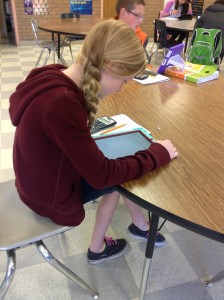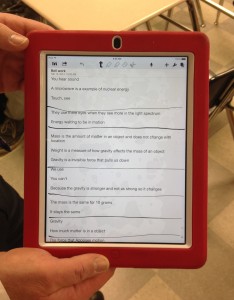
Apple has sold more than 7 million iPads to the U.S. education market since the product’s launch in 2010, according to “Apple Insider.”
The trend toward digital education is growing, as more and more school districts in the U.S. adopt 1-to-1 iPad initiatives. Though Rep. Becky Lockhart’s iPad initiative for Utah didn’t make the governor’s budget this year, it might be a possibility for the future.
Dixon Middle School in Provo is one of a few schools in Utah that has a 1-to-1 iPad initiative in operation. In November 2012, they were one of only three Utah schools to win a state grant providing an iPad for every student.
Principal Jarod Sites said they have already seen improvements in their students’ learning in the past year and a half.
“Writing has been the greatest improvement that we’ve seen,” he said. “Last year we saw our eighth grade writing scores surpass the 90 percent proficiency level.”
His teachers use iPads in all subjects, from Spanish to math. They have changed from paper textbooks to digital textbooks, giving the students access to videos, games, interactive reviews, online quizzes and more.
“For vocabulary this has been phenomenal,” said John Anderson, who teaches Spanish at Dixon.
Janelle Frossard, a BYU education student graduating this year, is a huge proponent of technology in the classroom.
“That’s the way we’re going, and that’s how it’s going to be, so might as well embrace it,” she said.
Frossard is currently teaching 10th grade English at Orem High School, and uses digital technology in her classroom nearly every day.
“We did a lesson about Twitter, and it was easily one of the most engaging discussions,” she said.
She has a classroom argumentative blog where students discuss their points of view on different pieces of literature.
Her school currently has a set of laptops the teachers can check out for their students, but she wishes each student had their own.

“It would be really helpful, mostly just with accessibility,” Frossard said. “I have students coming to me every day asking, ‘Are we blogging today?’ because they really like it.”
However, there is more to digital teaching than just a shiny new device.
“The difference isn’t so much with the technology, but how they are using the technology,” said Rick West, associate professor of the IP&T Department of the McKay School of Education. “Teaching strategies are most important.”
West’s department is constantly researching ways to improve learning through technology. Now, nearly every student who goes through BYU’s teaching program has to take a class in his department.
One big setback of the 1-to-1 initiative is the steep cost. Rep. Lockhart’s iPad initiative would have added a hefty $200 million to the governor’s education budget.
“Sometimes when people think of the true cost of a 1-to-1 initiative, they only think of the cost of the device, which is not the case,” Sites said.
He mentions other hidden costs, such as teacher training, breakage, content filtering systems and improvements to infrastructure.
However, West said there are some benefits that can help offset the cost of iPads in the classroom. He and fellow teachers have been researching a new possibility called “open textbooks,” digital textbooks compiled of free information from the Internet.
Along with saving the cost of paper textbooks, open textbooks would allow teachers to be more involved in their curriculum.
“If we have them help us create the right book, it can be customized to the classroom,” West said.
Sites said he believes the cost is worth it.
“If we are preparing our students for our past then it’s not a wise use of money,” he said. “But if we are preparing the students for the future we are going to live in, we have to use technology.”
Another issue iPads pose is potential distraction. However, Sites, Frossard and West all agreed that if teachers are having problems with distraction, the real problem is with classroom management.
“If you hold them accountable, most kids are smart enough that they will do their work first and the distractions will come later,” Frossard said.
West believes a 1-to-1 initiative is something Utah could be ready for in the near future.
“A reasonable rational person understands the importance of technology in the classroom. But every big idea needs a plan,” tweeted Gov. Herbert a few days before the budget for the 2015 fiscal year was finalized.




